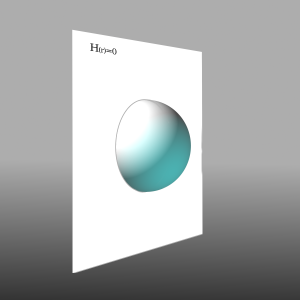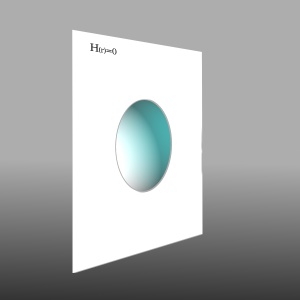
Figure 1: No surface at H(r) = 1 |

Figure 2: Convex surface at H(r) = 1 |
Figure 1 is a visual representation of a hole (the Schwarzschild radius, also called the gravitational radius) as a step function, where inside the hole H(r) =1, and outside the hole, which extends to infinity in this example, H(r)=0.
Figure 2 is a visual representation of a sheet intersecting the outer surface of a sphere for comparison.

Figure 3: Concave surface at H(r) = 1 |
A black hole I prefer to describe by Figure 1, one with no interior surfaces or walls.
The hole is circular at every angle. The images above are an aesthetic representation of a hole in a sheet from an angled perspective, and the angled perspective is used only for emphasis to distinguish the outside surface of a sphere, from the inside surface of a sphere, and a hole with no observable surfaces.
All sorts of things can be happening outside the hole, where H(r) = 0. This is not discussed anywhere here on this blog — on the contrary, there is nothing observable inside the hole, no observable inside surfaces. The only edge is a delta function at the Schwarzschild radius.
Again, inside the hole there are no walls like there is inside a cavity radiator. Furthermore, there are no angles in which the hole can be observed, as implied by the images.
The hole (Schwarzschild radius) is circular at every angle, and by definition radiates nothing. And the hole is not recognized to contain any inside surfaces, such as shown in representations above, and can not be anything else but a hole because there is no reflection nor propagation of light from any observable surfaces.
Nevertheless, an arbitrary surface could be mathematically constructed in a geometrically projected space. There are different ways to graphically represent and rationalize various surfaces with a black hole “surface,” such as projected surfaces, or as the surfaces of projections, and vice versa. But by definition, a black hole is a hole. Just outside the gravitational radius is the observable activity, turbulence, heat, light, etc.
Regardless of these surfaces or no-surfaces details, paths of gravitation in this region are stipulated to be inverted as a result of the geometry as described elsewhere on this blog in detail,1 its predicate is also discussed, its approximate scale, and where these boundaries may exist,2 and how to test for this type of “non-orientability,” whether this inversion exists or not.3
FOOTNOTES:
1. The Projection Geometry of a Theoretical Net-Zero Gravitational Field
2. A Theoretical Net-Zero Gravitational Field
3. Notes on the Black Hole Moon Schwarzschild Radius (0.11 mm) Projection
